
Illustrative Math Alignment: Grade 7 Unit 8
Probability and Sampling
Lesson 20: Memory Test
Use the following Media4Math resources with this Illustrative Math lesson.
| Thumbnail Image | Title | Body | Curriculum Topic |
|---|---|---|---|
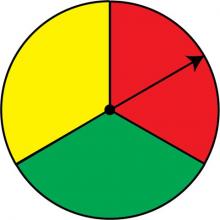
|
Math Clip Art: Spinner, 3 Sections--Result 2 | Math Clip Art: Spinner, 3 Sections--Result 2TopicProbability and Statistics DescriptionThis image showcases a spinner divided into three equal sections colored red, green, and yellow. The spinner's arrow points to the red section, demonstrating another possible outcome. In the context of Probability and Statistics, this spinner represents a probability experiment with three equally likely outcomes. It visually demonstrates the concepts of sample space and individual events within that space, each with a 1/3 probability of occurrence. |
Probability |

|
Math Clip Art: Spinner, 3 Sections--Result 3 | Math Clip Art: Spinner, 3 Sections--Result 3TopicProbability and Statistics DescriptionThis image depicts a spinner divided into three equal sections colored red, green, and yellow. The spinner's arrow points to the green section, showcasing the third possible outcome in this probability model. In Probability and Statistics, this spinner illustrates a fair probability experiment with three mutually exclusive and equally likely outcomes. It provides a visual representation of how each spin has an equal 1/3 chance of landing on any of the three colors. |
Probability |
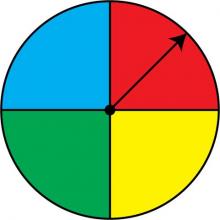
|
Math Clip Art: Spinner, 4 Sections--Result 1 | Math Clip Art: Spinner, 4 Sections--Result 1TopicProbability and Statistics DescriptionThis image features a spinner divided into four equal segments: red, yellow, green, and blue. The spinner's arrow points to the red section, depicting a sample outcome in this probability model. This spinner model is part of Probability and Statistics, as it visually exemplifies an experimental probability experiment with four equally likely sections, each representing a probability of 1/4. Teachers can use such images to facilitate discussions on probability, permutations, and likelihood, allowing students to explore and compare theoretical predictions with practical results. |
Probability |
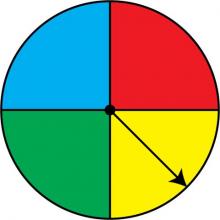
|
Math Clip Art: Spinner, 4 Sections--Result 2 | Math Clip Art: Spinner, 4 Sections--Result 2TopicProbability and Statistics DescriptionThis image showcases a spinner divided into four equal segments: red, yellow, green, and blue. The spinner's arrow points to the yellow section, illustrating another possible outcome in this probability model. As part of Probability and Statistics, this spinner visually represents an experimental probability scenario with four equally likely outcomes, each with a 1/4 probability of occurring. |
Probability |
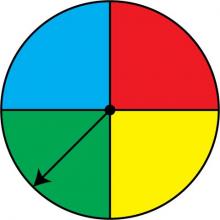
|
Math Clip Art: Spinner, 4 Sections--Result 3 | Math Clip Art: Spinner, 4 Sections--Result 3TopicProbability and Statistics DescriptionThis image depicts a spinner divided into four equal segments: red, yellow, green, and blue. The spinner's arrow points to the green section, showcasing another possible outcome in this probability model. In the context of Probability and Statistics, this spinner illustrates a fair probability experiment with four mutually exclusive and equally likely outcomes. It provides a visual representation of how each spin has an equal 1/4 chance of landing on any of the four colors. |
Probability |
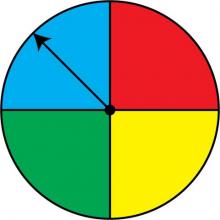
|
Math Clip Art: Spinner, 4 Sections--Result 4 | Math Clip Art: Spinner, 4 Sections--Result 4TopicProbability and Statistics DescriptionThis image presents a spinner divided into four equal segments: red, yellow, green, and blue. The spinner's arrow points to the blue section, completing the set of possible outcomes in this probability model. In the field of Probability and Statistics, this spinner exemplifies a uniform probability distribution with four equally likely outcomes. Each spin has a 1/4 probability of landing on any given color, illustrating the concept of equiprobable events. |
Probability |
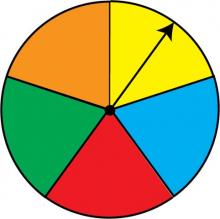
|
Math Clip Art: Spinner, 5 Sections--Result 1 | Math Clip Art: Spinner, 5 Sections--Result 1TopicProbability and Statistics DescriptionThis image displays a spinner divided into five equal sections: yellow, blue, red, green, and orange. The spinner's arrow currently points to the yellow section, indicating one of the five possible outcomes. In Probability and Statistics, this spinner serves as a vivid example of an experiment with multiple equally likely outcomes. Each section of the spinner represents a 1/5 probability, making it a useful tool for teaching the concept of equally probable events. |
Probability |

|
Math Clip Art: Spinner, 5 Sections--Result 2 | Math Clip Art: Spinner, 5 Sections--Result 2TopicProbability and Statistics DescriptionThis image presents a spinner divided into five equal sections: yellow, blue, red, green, and orange. The spinner's arrow is pointing to the orange section, demonstrating another possible outcome of this probability model. In the realm of Probability and Statistics, this spinner exemplifies a uniform probability distribution with five equally likely outcomes. Each spin has a 1/5 probability of landing on any given color, illustrating the concept of equiprobable events. |
Probability |
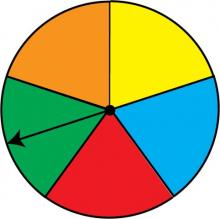
|
Math Clip Art: Spinner, 5 Sections--Result 3 | Math Clip Art: Spinner, 5 Sections--Result 3TopicProbability and Statistics DescriptionThis image showcases a spinner divided into five equal sections colored yellow, blue, red, green, and orange. The spinner's arrow points to the green section, demonstrating another possible outcome in this probability model. In the context of Probability and Statistics, this spinner represents a probability experiment with five equally likely outcomes. It visually demonstrates the concepts of sample space and individual events within that space, each with a 1/5 probability of occurrence. |
Probability |

|
Math Clip Art: Spinner, 5 Sections--Result 4 | Math Clip Art: Spinner, 5 Sections--Result 4TopicProbability and Statistics DescriptionThis image depicts a spinner divided into five equal sections colored yellow, blue, red, green, and orange. The spinner's arrow points to the red section, showcasing the fourth possible outcome in this probability model. In Probability and Statistics, this spinner illustrates a fair probability experiment with five mutually exclusive and equally likely outcomes. It provides a visual representation of how each spin has an equal 1/5 chance of landing on any of the five colors. |
Probability |
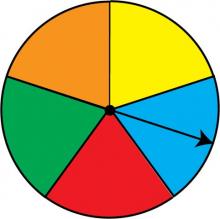
|
Math Clip Art: Spinner, 5 Sections--Result 5 | Math Clip Art: Spinner, 5 Sections--Result 5TopicProbability and Statistics DescriptionThis image presents a spinner divided into five equal sections: yellow, blue, red, green, and orange. The spinner's arrow points to the blue section, completing the set of possible outcomes in this probability model. In the field of Probability and Statistics, this spinner exemplifies a uniform probability distribution with five equally likely outcomes. Each spin has a 1/5 probability of landing on any given color, illustrating the concept of equiprobable events. |
Probability |

|
Math Clip Art: Spinner, 6 Sections--Result 1 | Math Clip Art: Spinner, 6 Sections--Result 1TopicProbability and Statistics DescriptionThis image displays a spinner divided into six equal sections: yellow, blue, orange, grey, red, and green. The spinner's arrow currently points to the red section, indicating one of the six possible outcomes. In Probability and Statistics, this spinner serves as a vivid example of an experiment with multiple equally likely outcomes. Each section of the spinner represents a 1/6 probability, making it a useful tool for teaching the concept of equally probable events. |
Probability |
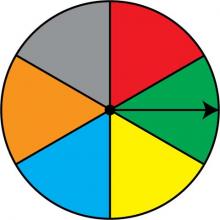
|
Math Clip Art: Spinner, 6 Sections--Result 2 | Math Clip Art: Spinner, 6 Sections--Result 2TopicProbability and Statistics DescriptionThis image displays a spinner divided into six equal sections: yellow, blue, orange, grey, red, and green. The spinner's arrow currently points to the green section, indicating one of the six possible outcomes. In Probability and Statistics, this spinner serves as a vivid example of an experiment with multiple equally likely outcomes. Each section of the spinner represents a 1/6 probability, making it a useful tool for teaching the concept of equally probable events. |
Probability |
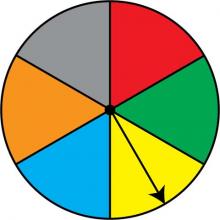
|
Math Clip Art: Spinner, 6 Sections--Result 3 | Math Clip Art: Spinner, 6 Sections--Result 3TopicProbability and Statistics DescriptionThis image displays a spinner divided into six equal sections: yellow, blue, orange, grey, red, and green. The spinner's arrow currently points to the yellow section, indicating one of the six possible outcomes. In Probability and Statistics, this spinner serves as a vivid example of an experiment with multiple equally likely outcomes. Each section of the spinner represents a 1/6 probability, making it a useful tool for teaching the concept of equally probable events. |
Probability |
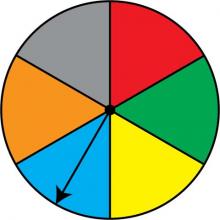
|
Math Clip Art: Spinner, 6 Sections--Result 4 | Math Clip Art: Spinner, 6 Sections--Result 4TopicProbability and Statistics DescriptionThis image displays a spinner divided into six equal sections: yellow, blue, orange, grey, red, and green. The spinner's arrow currently points to the blue section, indicating one of the six possible outcomes. In Probability and Statistics, this spinner serves as a vivid example of an experiment with multiple equally likely outcomes. Each section of the spinner represents a 1/6 probability, making it a useful tool for teaching the concept of equally probable events. |
Probability |

|
Math Clip Art: Spinner, 6 Sections--Result 5 | Math Clip Art: Spinner, 6 Sections--Result 5TopicProbability and Statistics DescriptionThis image displays a spinner divided into six equal sections: yellow, blue, orange, grey, red, and green. The spinner's arrow currently points to the orange section, indicating one of the six possible outcomes. In Probability and Statistics, this spinner serves as a vivid example of an experiment with multiple equally likely outcomes. Each section of the spinner represents a 1/6 probability, making it a useful tool for teaching the concept of equally probable events. |
Probability |
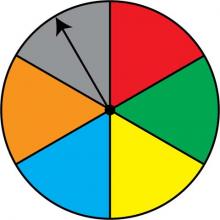
|
Math Clip Art: Spinner, 6 Sections--Result 6 | Math Clip Art: Spinner, 6 Sections--Result 6TopicProbability and Statistics DescriptionThis image displays a spinner divided into six equal sections: yellow, blue, orange, grey, red, and green. The spinner's arrow currently points to the grey section, indicating one of the six possible outcomes. In Probability and Statistics, this spinner serves as a vivid example of an experiment with multiple equally likely outcomes. Each section of the spinner represents a 1/6 probability, making it a useful tool for teaching the concept of equally probable events. |
Probability |
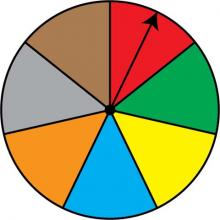
|
Math Clip Art: Spinner, 7 Sections--Result 1 | Math Clip Art: Spinner, 7 Sections--Result 1TopicProbability and Statistics DescriptionThis image showcases a spinner divided into seven equal sections colored red, green, yellow, blue, orange, grey, and brown. The spinner's arrow points to the red section, illustrating one of the seven possible outcomes. In the context of Probability and Statistics, this spinner represents a more complex probability model with seven equally likely outcomes. Each section has a probability of 1/7, demonstrating how probability changes as the number of possible outcomes increases. |
Probability |
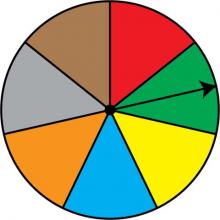
|
Math Clip Art: Spinner, 7 Sections--Result 2 | Math Clip Art: Spinner, 7 Sections--Result 2TopicProbability and Statistics DescriptionThis image presents a spinner divided into seven equal sections colored red, green, yellow, blue, orange, grey, and brown. The spinner's arrow points to the green section, showcasing another possible outcome in this probability model. In Probability and Statistics, this spinner illustrates a fair probability experiment with seven mutually exclusive and equally likely outcomes. It provides a visual representation of how each spin has an equal 1/7 chance of landing on any of the seven colors. |
Probability |
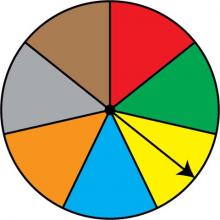
|
Math Clip Art: Spinner, 7 Sections--Result 3 | Math Clip Art: Spinner, 7 Sections--Result 3TopicProbability and Statistics DescriptionThis image displays a spinner divided into seven equal sections colored red, green, yellow, blue, orange, grey, and brown. The spinner's arrow points to the yellow section, demonstrating the third possible outcome in this probability model. In the field of Probability and Statistics, this spinner exemplifies a uniform probability distribution with seven equally likely outcomes. Each spin has a 1/7 probability of landing on any given color, illustrating the concept of equiprobable events in a more complex scenario. |
Probability |
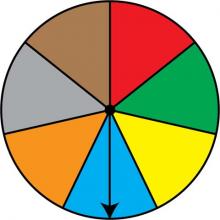
|
Math Clip Art: Spinner, 7 Sections--Result 4 | Math Clip Art: Spinner, 7 Sections--Result 4TopicProbability and Statistics DescriptionThis image features a spinner divided into seven equal segments colored red, green, yellow, blue, orange, grey, and brown. The spinner's arrow points to the blue section, depicting the fourth possible outcome in this probability model. In Probability and Statistics, this spinner serves as a vivid example of an experiment with multiple equally likely outcomes. Each section of the spinner represents a 1/7 probability, making it a useful tool for teaching the concept of equally probable events in more complex scenarios. |
Probability |
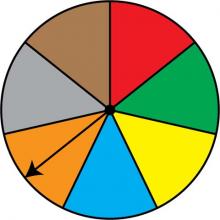
|
Math Clip Art: Spinner, 7 Sections--Result 5 | Math Clip Art: Spinner, 7 Sections--Result 5TopicProbability and Statistics DescriptionThis image presents a spinner divided into seven equal sections colored red, green, yellow, blue, orange, grey, and brown. The spinner's arrow points to the orange section, illustrating the fifth possible outcome in this probability model. In the realm of Probability and Statistics, this spinner exemplifies a uniform probability distribution with seven equally likely outcomes. Each spin has a 1/7 probability of landing on any given color, demonstrating how probability concepts apply in scenarios with multiple outcomes. |
Probability |

|
Math Clip Art: Spinner, 7 Sections--Result 6 | Math Clip Art: Spinner, 7 Sections--Result 6TopicProbability and Statistics DescriptionThis image showcases a spinner divided into seven equal sections colored red, green, yellow, blue, orange, grey, and brown. The spinner's arrow points to the grey section, demonstrating the sixth possible outcome in this probability model. In the context of Probability and Statistics, this spinner represents a more complex probability experiment with seven equally likely outcomes. It visually demonstrates the concepts of sample space and individual events within that space, each with a 1/7 probability of occurrence. |
Probability |
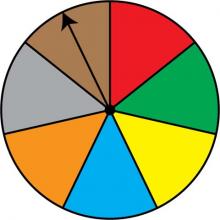
|
Math Clip Art: Spinner, 7 Sections--Result 7 | Math Clip Art: Spinner, 7 Sections--Result 7TopicProbability and Statistics DescriptionThis image depicts a spinner divided into seven equal sections colored red, green, yellow, blue, orange, grey, and brown. The spinner's arrow points to the brown section, showcasing the final possible outcome in this probability model. In Probability and Statistics, this spinner illustrates a fair probability experiment with seven mutually exclusive and equally likely outcomes. It provides a visual representation of how each spin has an equal 1/7 chance of landing on any of the seven colors, demonstrating complex probability scenarios. |
Probability |
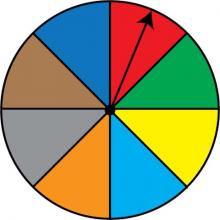
|
Math Clip Art: Spinner, 8 Sections--Result 1 | Math Clip Art: Spinner, 8 Sections--Result 1TopicProbability and Statistics DescriptionThis image features a spinner divided into eight equal sections colored red, green, yellow, light blue, orange, grey, brown, and dark blue. The spinner's arrow points to the red section, demonstrating one of the possible outcomes. In the realm of Probability and Statistics, this spinner illustrates how the sample space expands with more outcomes, each having an equal probability of 1/8. It serves as an excellent tool for teaching about equiprobable events in complex scenarios. |
Probability |
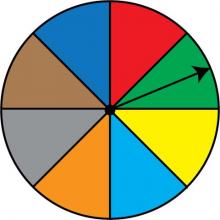
|
Math Clip Art: Spinner, 8 Sections--Result 2 | Math Clip Art: Spinner, 8 Sections--Result 2TopicProbability and Statistics DescriptionThis image features a spinner divided into eight equal sections colored red, green, yellow, light blue, orange, grey, brown, and dark blue. The spinner's arrow points to the green section, demonstrating one of the possible outcomes. In the realm of Probability and Statistics, this spinner illustrates how the sample space expands with more outcomes, each having an equal probability of 1/8. It serves as an excellent tool for teaching about equiprobable events in complex scenarios. |
Probability |
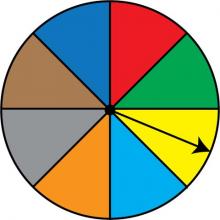
|
Math Clip Art: Spinner, 8 Sections--Result 3 | Math Clip Art: Spinner, 8 Sections--Result 3TopicProbability and Statistics DescriptionThis image features a spinner divided into eight equal sections colored red, green, yellow, light blue, orange, grey, brown, and dark blue. The spinner's arrow points to the yellow section, demonstrating one of the possible outcomes. In the realm of Probability and Statistics, this spinner illustrates how the sample space expands with more outcomes, each having an equal probability of 1/8. It serves as an excellent tool for teaching about equiprobable events in complex scenarios. |
Probability |

|
Math Clip Art: Spinner, 8 Sections--Result 4 | Math Clip Art: Spinner, 8 Sections--Result 4TopicProbability and Statistics DescriptionThis image features a spinner divided into eight equal sections colored red, green, yellow, light blue, orange, grey, brown, and dark blue. The spinner's arrow points to the light blue section, demonstrating one of the possible outcomes. In the realm of Probability and Statistics, this spinner illustrates how the sample space expands with more outcomes, each having an equal probability of 1/8. It serves as an excellent tool for teaching about equiprobable events in complex scenarios. |
Probability |
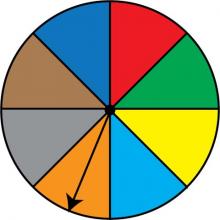
|
Math Clip Art: Spinner, 8 Sections--Result 5 | Math Clip Art: Spinner, 8 Sections--Result 5TopicProbability and Statistics DescriptionThis image features a spinner divided into eight equal sections colored red, green, yellow, light blue, orange, grey, brown, and dark blue. The spinner's arrow points to the orange section, demonstrating one of the possible outcomes. In the realm of Probability and Statistics, this spinner illustrates how the sample space expands with more outcomes, each having an equal probability of 1/8. It serves as an excellent tool for teaching about equiprobable events in complex scenarios. |
Probability |
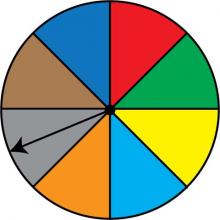
|
Math Clip Art: Spinner, 8 Sections--Result 6 | Math Clip Art: Spinner, 8 Sections--Result 6TopicProbability and Statistics DescriptionThis image features a spinner divided into eight equal sections colored red, green, yellow, light blue, orange, grey, brown, and dark blue. The spinner's arrow points to the grey section, demonstrating one of the possible outcomes. In the realm of Probability and Statistics, this spinner illustrates how the sample space expands with more outcomes, each having an equal probability of 1/8. It serves as an excellent tool for teaching about equiprobable events in complex scenarios. |
Probability |

|
Math Clip Art: Spinner, 8 Sections--Result 7 | Math Clip Art: Spinner, 8 Sections--Result 7TopicProbability and Statistics DescriptionThis image features a spinner divided into eight equal sections colored red, green, yellow, light blue, orange, grey, brown, and dark blue. The spinner's arrow points to the brown section, demonstrating one of the possible outcomes. In the realm of Probability and Statistics, this spinner illustrates how the sample space expands with more outcomes, each having an equal probability of 1/8. It serves as an excellent tool for teaching about equiprobable events in complex scenarios. |
Probability |
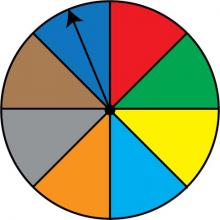
|
Math Clip Art: Spinner, 8 Sections--Result 8 | Math Clip Art: Spinner, 8 Sections--Result 8TopicProbability and Statistics DescriptionThis image features a spinner divided into eight equal sections colored red, green, yellow, light blue, orange, grey, brown, and dark blue. The spinner's arrow points to the dark blue section, demonstrating one of the possible outcomes. In the realm of Probability and Statistics, this spinner illustrates how the sample space expands with more outcomes, each having an equal probability of 1/8. It serves as an excellent tool for teaching about equiprobable events in complex scenarios. |
Probability |
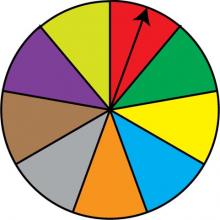
|
Math Clip Art: Spinner, 9 Sections--Result 1 | Math Clip Art: Spinner, 9 Sections--Result 1TopicProbability and Statistics DescriptionThis image features a spinner divided into nine equal sections colored red, green, dark yellow, light blue, orange, grey, brown, purple, and light yellow. The spinner's arrow points to the red section, demonstrating one of the nine possible outcomes. In the realm of Probability and Statistics, this spinner illustrates how the sample space expands with more outcomes, each having an equal probability of 1/9. It serves as an excellent tool for teaching about equiprobable events in complex scenarios. |
Probability |
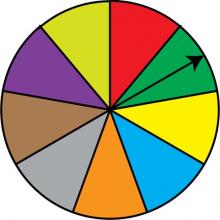
|
Math Clip Art: Spinner, 9 Sections--Result 2 | Math Clip Art: Spinner, 9 Sections--Result 2TopicProbability and Statistics DescriptionThis image showcases a spinner divided into nine equal sections colored red, green, dark yellow, light blue, orange, grey, brown, purple, and light yellow. The spinner's arrow points to the green section, illustrating another possible outcome. In Probability and Statistics, this spinner represents a fair probability experiment with nine mutually exclusive and equally likely outcomes. It provides a visual representation of how each spin has an equal 1/9 chance of landing on any of the nine colors. |
Probability |

|
Math Clip Art: Spinner, 9 Sections--Result 3 | Math Clip Art: Spinner, 9 Sections--Result 3TopicProbability and Statistics DescriptionThis image displays a spinner divided into nine equal sections colored red, green, dark yellow, light blue, orange, grey, brown, purple, and light yellow. The spinner's arrow points to the dark yellow section, showcasing another possible outcome in this probability model. In the field of Probability and Statistics, this spinner exemplifies a uniform probability distribution with nine equally likely outcomes. Each spin has a 1/9 probability of landing on any given color, illustrating the concept of equiprobable events in a more complex scenario. |
Probability |
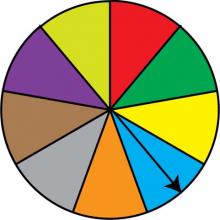
|
Math Clip Art: Spinner, 9 Sections--Result 4 | Math Clip Art: Spinner, 9 Sections--Result 4TopicProbability and Statistics DescriptionThis image presents a spinner divided into nine equal sections colored red, green, dark yellow, light blue, orange, grey, brown, purple, and light yellow. The spinner's arrow points to the light blue section, demonstrating another possible outcome in this probability model. In Probability and Statistics, this spinner illustrates a fair probability experiment with nine mutually exclusive and equally likely outcomes. It provides a visual representation of how each spin has an equal 1/9 chance of landing on any of the nine colors. |
Probability |
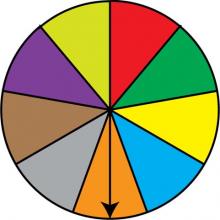
|
Math Clip Art: Spinner, 9 Sections--Result 5 | Math Clip Art: Spinner, 9 Sections--Result 5TopicProbability and Statistics DescriptionThis image showcases a spinner divided into nine equal sections colored red, green, dark yellow, light blue, orange, grey, brown, purple, and light yellow. The spinner's arrow points to the orange section, illustrating another possible outcome in this probability model. In the context of Probability and Statistics, this spinner represents a probability experiment with nine equally likely outcomes. It visually demonstrates the concepts of sample space and individual events within that space, each with a 1/9 probability of occurrence. |
Probability |
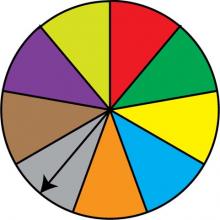
|
Math Clip Art: Spinner, 9 Sections--Result 6 | Math Clip Art: Spinner, 9 Sections--Result 6TopicProbability and Statistics DescriptionThis image displays a spinner divided into nine equal sections colored red, green, dark yellow, light blue, orange, grey, brown, purple, and light yellow. The spinner's arrow points to the grey section, showcasing another possible outcome in this probability model. In the field of Probability and Statistics, this spinner exemplifies a uniform probability distribution with nine equally likely outcomes. Each spin has a 1/9 probability of landing on any given color, illustrating the concept of equiprobable events in a more complex scenario. |
Probability |
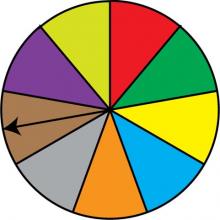
|
Math Clip Art: Spinner, 9 Sections--Result 7 | Math Clip Art: Spinner, 9 Sections--Result 7TopicProbability and Statistics DescriptionThis image presents a spinner divided into nine equal sections colored red, green, dark yellow, light blue, orange, grey, brown, purple, and light yellow. The spinner's arrow points to the brown section, demonstrating another possible outcome in this probability model. In Probability and Statistics, this spinner illustrates a fair probability experiment with nine mutually exclusive and equally likely outcomes. It provides a visual representation of how each spin has an equal 1/9 chance of landing on any of the nine colors. |
Probability |

|
Math Clip Art: Spinner, 9 Sections--Result 8 | Math Clip Art: Spinner, 9 Sections--Result 8TopicProbability and Statistics DescriptionThis image showcases a spinner divided into nine equal sections colored red, green, dark yellow, light blue, orange, grey, brown, purple, and light yellow. The spinner's arrow points to the purple section, illustrating another possible outcome in this probability model. In the context of Probability and Statistics, this spinner represents a probability experiment with nine equally likely outcomes. It visually demonstrates the concepts of sample space and individual events within that space, each with a 1/9 probability of occurrence. |
Probability |
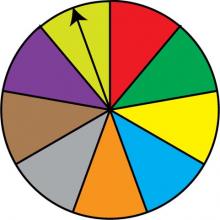
|
Math Clip Art: Spinner, 9 Sections--Result 9 | Math Clip Art: Spinner, 9 Sections--Result 9TopicProbability and Statistics DescriptionThis image displays a spinner divided into nine equal sections colored red, green, dark yellow, light blue, orange, grey, brown, purple, and light yellow. The spinner's arrow points to the light yellow section, showcasing the final possible outcome in this probability model. In the field of Probability and Statistics, this spinner exemplifies a uniform probability distribution with nine equally likely outcomes. Each spin has a 1/9 probability of landing on any given color, illustrating the concept of equiprobable events in a more complex scenario. |
Probability |
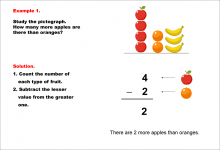
|
Math Example--Charts, Graphs, and Plots--Reading and Interpreting Scaled Graphs--Example 1 | Math Example--Charts, Graphs, and Plots-- Reading and Interpreting Scaled Graphs--Example 1
In this set of math examples, analyze the behavior of different scatterplots. This includes linear and quadratic models. |
Subtraction Facts to 100 and Data Analysis |
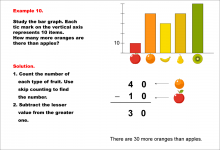
|
Math Example--Charts, Graphs, and Plots--Reading and Interpreting Scaled Graphs--Example 10 | Math Example--Charts, Graphs, and Plots-- Reading and Interpreting Scaled Graphs--Example 10
In this set of math examples, analyze the behavior of different scatterplots. This includes linear and quadratic models. |
Subtraction Facts to 100 and Data Analysis |
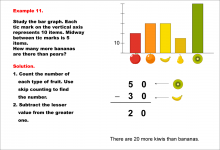
|
Math Example--Charts, Graphs, and Plots--Reading and Interpreting Scaled Graphs--Example 11 | Math Example--Charts, Graphs, and Plots-- Reading and Interpreting Scaled Graphs--Example 11
In this set of math examples, analyze the behavior of different scatterplots. This includes linear and quadratic models. |
Subtraction Facts to 100 and Data Analysis |
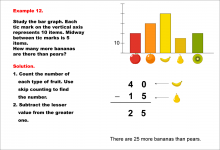
|
Math Example--Charts, Graphs, and Plots--Reading and Interpreting Scaled Graphs--Example 12 | Math Example--Charts, Graphs, and Plots-- Reading and Interpreting Scaled Graphs--Example 12
In this set of math examples, analyze the behavior of different scatterplots. This includes linear and quadratic models. |
Subtraction Facts to 100 and Data Analysis |

|
Math Example--Charts, Graphs, and Plots--Reading and Interpreting Scaled Graphs--Example 13 | Math Example--Charts, Graphs, and Plots-- Reading and Interpreting Scaled Graphs--Example 13
In this set of math examples, analyze the behavior of different scatterplots. This includes linear and quadratic models. |
Subtraction Facts to 100 and Data Analysis |
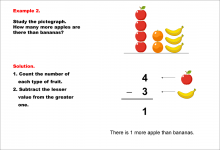
|
Math Example--Charts, Graphs, and Plots--Reading and Interpreting Scaled Graphs--Example 2 | Math Example--Charts, Graphs, and Plots-- Reading and Interpreting Scaled Graphs--Example 2
In this set of math examples, analyze the behavior of different scatterplots. This includes linear and quadratic models. |
Subtraction Facts to 100 and Data Analysis |
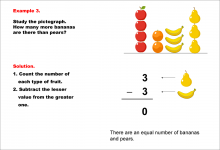
|
Math Example--Charts, Graphs, and Plots--Reading and Interpreting Scaled Graphs--Example 3 | Math Example--Charts, Graphs, and Plots-- Reading and Interpreting Scaled Graphs--Example 3
In this set of math examples, analyze the behavior of different scatterplots. This includes linear and quadratic models. |
Subtraction Facts to 100 and Data Analysis |

|
Math Example--Charts, Graphs, and Plots--Reading and Interpreting Scaled Graphs--Example 4 | Math Example--Charts, Graphs, and Plots-- Reading and Interpreting Scaled Graphs--Example 4
In this set of math examples, analyze the behavior of different scatterplots. This includes linear and quadratic models. |
Subtraction Facts to 100 and Data Analysis |
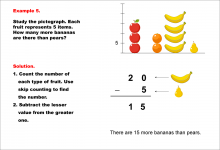
|
Math Example--Charts, Graphs, and Plots--Reading and Interpreting Scaled Graphs--Example 5 | Math Example--Charts, Graphs, and Plots-- Reading and Interpreting Scaled Graphs--Example 5
In this set of math examples, analyze the behavior of different scatterplots. This includes linear and quadratic models. |
Subtraction Facts to 100 and Data Analysis |